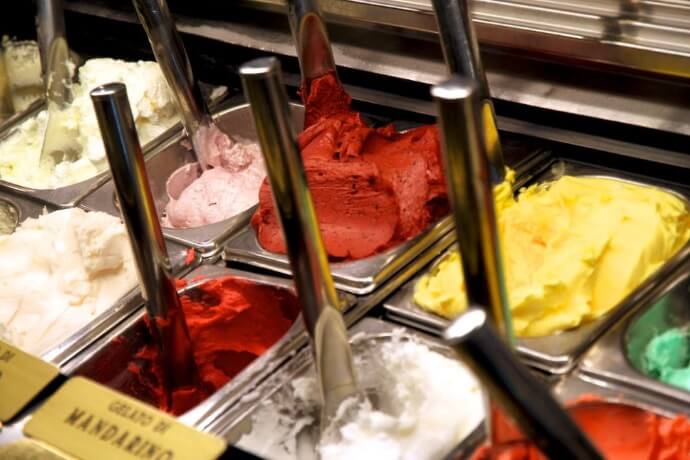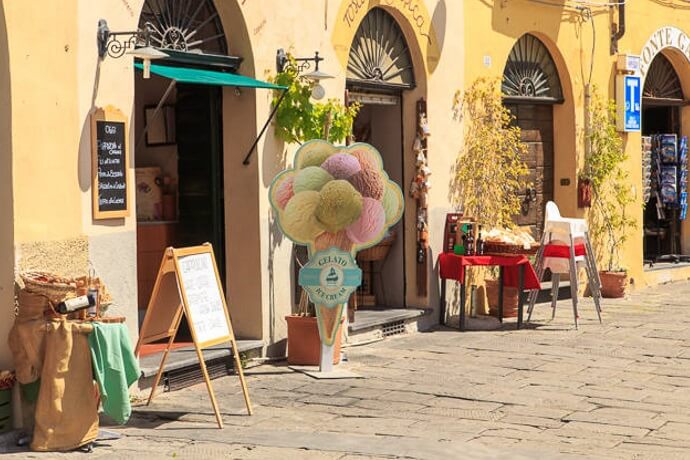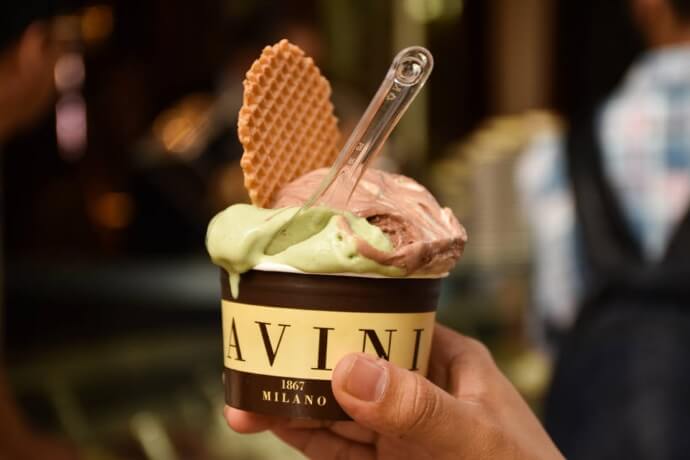Eating an ice-cream is like waiting for your favorite TV show to start, but instead of a cliffhanger, you are eagerly waiting for that first lick, like it's the tastiest plot twist ever! Sometimes, the coldness hits you like a surprise Arctic blast and suddenly you're left with a brain freeze that makes you question all your life choices. But hey, who needs logic when you've got ice cream, right?
As your tongue dives into the creamy goodness, it does a little victory dance, showcasing its agility and flexibility. It's like a tongue Olympics, where the gold medal goes to the most expert licker! Every spoonful is like embarking on a flavor adventure. With each bite, a wave of satisfaction washes over you, as if all your problems have momentarily melted away. Ice cream has the magical power to turn frowns upside down and transform any day into a sweet victory. So, grab a spoon and join us in an enjoyable reading about the typical Italian Gelato.
The origins and history

The origins of what nowadays we know as ice-cream, can be traced back to ancient China, where a frozen mixture of milk and rice was created around 200 BC. This concept later spread to other parts of Asia and eventually reached Europe through the Arab traders. However, it was in Italy where ice-cream truly evolved and became an integral part of the Italian culinary tradition as the Italian Gelato.
During the medieval period in Italy, the art of making frozen desserts began to flourish. In the 13th century, Marco Polo returned from his travels to the Far East with various recipes and ingredients, including the concept of a frozen treat. These influences played a crucial role in the development of gelato in Italy. By the Renaissance period, it had become a delicacy favored by the Italian nobility. The Medici family, a prominent Italian dynasty, had a significant impact on the evolution of gelato. They invited a prominent chef named Ruggeri to their court, who refined the gelato-making techniques and introduced new flavors. It was during this time that the first "gelato cafes" or "gelaterias" began to appear in Italy. In the 18th century, the popularity of gelato continued to grow. Italian chefs and artisans experimented with different ingredients and techniques to enhance the flavor and texture of gelato. They developed innovative methods to freeze the dessert using ice and salt, allowing for smoother and creamier textures.
Today, gelato is considered a quintessential Italian dessert, renowned for its smooth and creamy texture, intense flavors, and artisanal craftsmanship. Traditional gelato is made using milk, sugar, and natural flavorings such as fruits, nuts, chocolate, and coffee. It contains less fat than ice cream but has a denser consistency. Italian gelato artisans take pride in their craftsmanship and the use of high-quality ingredients. They continue to innovate by introducing new flavors and techniques, pushing the boundaries of traditional gelato-making.
What makes the Italian Gelato so popular and globally acclaimed?

The Italian Gelato has a distinctively smooth and creamy texture that sets it apart from other frozen desserts. It is denser and silkier compared to traditional ice cream. This unique texture is achieved by using a lower fat content and a slower churning process, which results in less air incorporation. Gelato makers often use high-quality ingredients, such as fresh fruits, nuts and chocolate, to create authentic and rich flavors. The lower fat content allows the flavors to shine through, giving a more concentrated taste experience. From traditional favorites like stracciatella (chocolate chip) and pistachio to more unique combinations like fig and balsamic vinegar, there is something for everyone. The versatility of gelato allows for endless flavor possibilities, enticing customers with exciting and innovative creations. Gelato production in Italy is often viewed as a true art form.
Gelato holds a special place in Italian culture and tradition. Italian gelato shops, known as "gelaterias", are iconic establishments found in almost every city and town in Italy. They serve as gathering places for locals and tourists alike, fostering a sense of community and shared enjoyment. The “geliateris” are renowned for their continuous pursuit of excellence and innovation. They constantly strive to push the boundaries of flavor and technique, incorporating new ingredients, experimenting with unique combinations, and embracing modern advancements while maintaining the essence of traditional gelato-making methods.
Italian immigrants and their descendants have spread the art of gelato-making worldwide. Gelato shops inspired by the Italian tradition can be found in numerous countries, allowing people from different cultures to experience and appreciate the delights of authentic Italian gelato.
Once in Italy, where can you have an authentic gelato experience?

By now, our dear readers must be eager to travel to Italy just to try an authentic Gelato. Here are some suggestions of worth-visiting gelaterias:
Gelateria dei Neri: Nestled in the heart of Florence, Gelateria dei Neri is a beloved spot for ice-cream enthusiasts. With an impressive variety of flavors, including classics like pistachio and stracciatella and innovative creations like ricotta and fig, this place will make your taste buds do a happy dance.
Gelateria del Teatro: Located near the charming Piazza Navona in Rome, Gelateria del Teatro is an unmissable gem. Their artisanal ice-cream is made with fresh and seasonal ingredients, resulting in delightful flavors like dark chocolate with orange zest and fig and ricotta. Plus, you can even see the gelato being prepared right before your eyes!
Gelateria Gianni: Once in Bologna, Gelateria Gianni is a must-visit. This family-owned gelateria has been delighting locals and visitors since 1970. Their ice-cream is made with passion and traditional techniques, offering a wide range of flavors that change with the seasons. We suggest you try their famous "Crema Gianduia" for a heavenly hazelnut and chocolate experience.
Gelateria La Romana: In the vibrant city of Turin, this is also a top spot for ice-cream lovers. Known for their exceptional quality and creamy textures, they offer an array of classic and innovative flavors. Their signature "Crema La Romana" and the luscious "Zabaione" gelato are absolutely delicious.
The recipe

The recipe for the traditional Italian gelato involves a few basic ingredients and a specific method of preparation.
Ingredients:
2 cups whole milk
1 cup heavy cream
3/4 cup granulated sugar
4-6 large egg yolks
Flavorings (such as vanilla extract, cocoa powder, fruit puree, etc.)
- In a saucepan, combine the milk and heavy cream. Heat the mixture over medium heat until it reaches a scalding point, just before it starts to boil. Remove from heat.
- In a separate bowl, whisk together the sugar and egg yolks until well combined and creamy.
- Slowly pour the hot milk and cream mixture into the bowl with the sugar and egg yolks, while continuously whisking to temper the eggs. This step prevents the eggs from curdling.
- Pour the mixture back into the saucepan and return it to the stove over low heat. Cook the mixture, stirring constantly, until it thickens slightly and coats the back of a spoon. This custard base should have a smooth texture.
- Remove the saucepan from heat and let the custard cool to room temperature. You can speed up the cooling process by placing the saucepan in an ice bath and stirring occasionally.
- Once the custard has cooled, you can add your desired flavorings, such as vanilla extract, cocoa powder, fruit puree, or any other flavorings you prefer. Mix well to incorporate the flavors.
- Cover the custard and refrigerate for at least 4 hours or overnight to allow the flavors to meld and the mixture to chill thoroughly.
- Once chilled, transfer the custard to an ice cream maker and churn accordingly. The gelato should have a soft, creamy consistency.
- If you prefer a firmer gelato, transfer the churned gelato to an airtight container and freeze for an additional 2-4 hours or until it reaches the desired firmness.
Remember, the key to traditional Italian Gelato lies in using high-quality ingredients and taking the time to create a smooth and creamy custard base, known as Fior de Panna.



